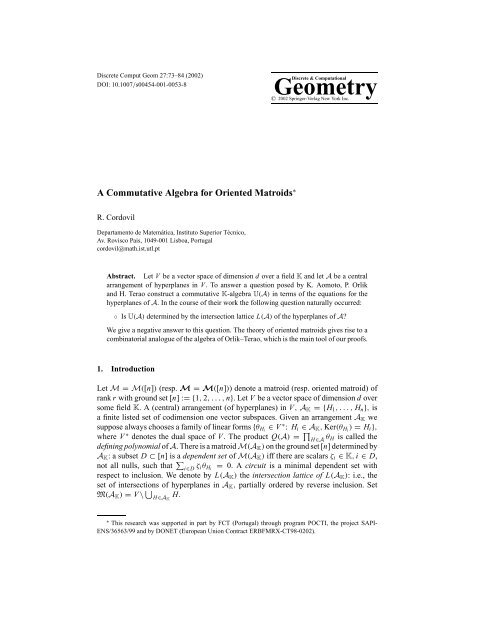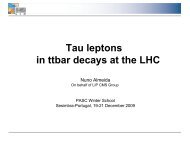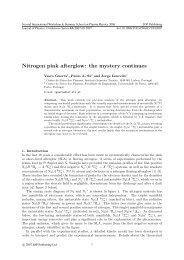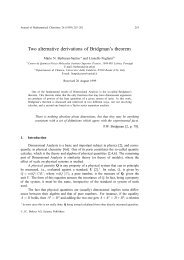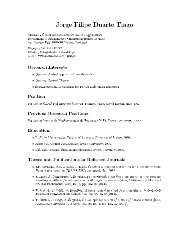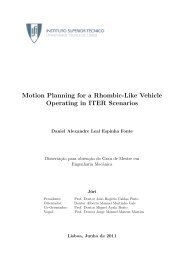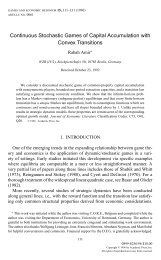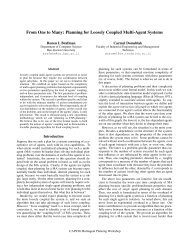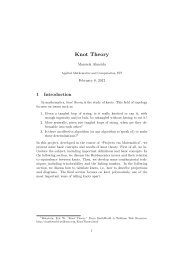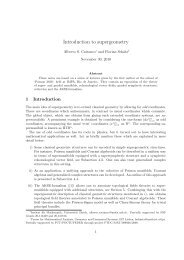A Commutative Algebra for Oriented Matroids
A Commutative Algebra for Oriented Matroids
A Commutative Algebra for Oriented Matroids
Create successful ePaper yourself
Turn your PDF publications into a flip-book with our unique Google optimized e-Paper software.
Discrete Comput Geom 27:73–84 (2002)<br />
DOI: 10.1007/s00454-001-0053-8<br />
Discrete & Computational<br />
Geometry<br />
© 2002 Springer-Verlag New York Inc.<br />
A <strong>Commutative</strong> <strong>Algebra</strong> <strong>for</strong> <strong>Oriented</strong> <strong>Matroids</strong> ∗<br />
R. Cordovil<br />
Departamento de Matemática, Instituto Superior Técnico,<br />
Av. Rovisco Pais, 1049-001 Lisboa, Portugal<br />
cordovil@math.ist.utl.pt<br />
Abstract. Let V be a vector space of dimension d over a field K and let A be a central<br />
arrangement of hyperplanes in V. To answer a question posed by K. Aomoto, P. Orlik<br />
and H. Terao construct a commutative K-algebra U(A) in terms of the equations <strong>for</strong> the<br />
hyperplanes of A. In the course of their work the following question naturally occurred:<br />
◦ Is U(A) determined by the intersection lattice L(A) of the hyperplanes of A<br />
We give a negative answer to this question. The theory of oriented matroids gives rise to a<br />
combinatorial analogue of the algebra of Orlik–Terao, which is the main tool of our proofs.<br />
1. Introduction<br />
Let M = M([n]) (resp. M = M([n])) denote a matroid (resp. oriented matroid) of<br />
rank r with ground set [n] :={1, 2,...,n}. Let V be a vector space of dimension d over<br />
some field K. A (central) arrangement (of hyperplanes) in V, A K ={H 1 ,...,H n }, is<br />
a finite listed set of codimension one vector subspaces. Given an arrangement A K we<br />
suppose always chooses a family of linear <strong>for</strong>ms {θ Hi ∈ V ∗ : H i ∈ A K , Ker(θ Hi ) = H i },<br />
where V ∗ denotes the dual space of V. The product Q(A) = ∏ H∈A θ H is called the<br />
defining polynomial of A. There is a matroid M(A K ) on the ground set [n] determined by<br />
A K : a subset D ⊂ [n] isadependent set of M(A K ) iff there are scalars ζ i ∈ K, i ∈ D,<br />
not all nulls, such that ∑ i∈D ζ iθ Hi = 0. A circuit is a minimal dependent set with<br />
respect to inclusion. We denote by L(A K ) the intersection lattice of L(A K ): i.e., the<br />
set of intersections of hyperplanes in A K , partially ordered by reverse inclusion. Set<br />
M(A K ) = V \ ⋃ H∈A K<br />
H.<br />
∗ This research was supported in part by FCT (Portugal) through program POCTI, the project SAPI-<br />
ENS/36563/99 and by DONET (European Union Contract ERBFMRX-CT98-0202).
74 R. Cordovil<br />
Aomoto suggested the study of the (graded) K-vector space AO(A K ), generated by<br />
the basis {Q(B I ) −1 }, where I is an independent set of M(A K ), B I :={H i ∈ A K : i ∈ I }<br />
and Q(B I ) = ∏ i∈I θ H i<br />
denotes the corresponding defining polynomial. In [1] it is<br />
conjectured that<br />
dim(AO(A R )) = number of chambers of M(A R ).<br />
To prove Aomoto’s conjecture, Orlik and Terao have constructed in [8] a commutative<br />
K-algebra, U(A K ), isomorphic to AO(A K ) as a graded K-vector space in terms of the<br />
equations {θ H : H ∈ A K }. The authors note that it is not clear whether U(A K ) itself<br />
depends only on the intersection lattice L(A K ).<br />
To every oriented matroid M we associate a commutative Z-algebra, denoted by<br />
A(M). This algebra is the “combinatorial analogue” of the algebra of Orlik–Terao and<br />
it is the main tool to give a negative answer to the question of Orlik–Terao.<br />
We use [9] and [10] as a general reference in matroid theory. We refer to [2] and [7]<br />
<strong>for</strong> good sources of the theory of oriented matroids and arrangements of hyperplanes,<br />
respectively.<br />
2. Two <strong>Commutative</strong> <strong>Algebra</strong>s<br />
Let IND l (M) ⊂ ( )<br />
[n]<br />
l be the family of the independent sets of cardinal l of the matroid<br />
M and set IND(M) = ⋃ l∈N IND l(M). We denote by C = C(M) the set of circuits<br />
of M. When the smallest element α of a circuit C, |C| > 1, is deleted, the remaining<br />
set, C\α, is said to be a broken circuit. (Note that our definition is slightly different to<br />
the standard one. In the standard definition C\α can be empty.) To shorten the notation<br />
the singleton set {x} is denoted by x. A no broken circuit set of a matroid M is an<br />
( independent subset of [n] which does not contain any broken circuit. Let NBC l (M) ⊂<br />
[n]<br />
)<br />
⋃l<br />
be the set of the no broken circuit sets of cardinal l of M. Set NBC(M) =<br />
l∈N NBC l(M). We denote by L(M) the lattice of flats of M. (We remark that the<br />
lattice map ϕ: L(A K ) → L(M(A K )), determined by the one-to-one correspondence<br />
ϕ ′ : H i ←→ {i}, i = 1,...,n, is a lattice isomorphism.) Consider now an independent<br />
set X. Let cl M (X) be (or shortly cl(X)) the closure of X in M. Pick an element<br />
x ∈ cl(X)\X. Let C(X, x) denote the unique circuit of M contained in X ∪ x. For<br />
every X ∈ IND(M), set<br />
EA(X) := {x ∈ cl(X)\X: x is the minimum of C(X, x) and C(X, x) ≠ {x}}.<br />
(The elements of EA(X) are usually called the externally active elements of X.) So, <strong>for</strong><br />
every independent set X of M, X ∈ NBC(M) iff EA(X) =∅. If EA(X) ≠ ∅, let α(X)<br />
denote the smallest element of EA(X).<br />
Here, every map X: [n] → {+1, −1, 0} ⊂ Z is called a signed set on [n]. Set<br />
X + ={l ∈ [n]: X(l) =+1}, X − ={l ∈ [n]: X(l) =−1}. We say that X := X + ∪ X −<br />
is the support of X, or X is a signed set supporting X. A signed set X con<strong>for</strong>ms to a<br />
signed set Y if X + ⊂ Y + and X − ⊂ Y − . For every x ∈ [n] and signed set X let X\x<br />
be the signed set on [n]\x, con<strong>for</strong>ming to X and supporting X\x. We say that a signed<br />
set X is the union of the signed sets X 1 ,...,X m if X = X 1 ∪···∪X m and every X i<br />
con<strong>for</strong>ms to X. The reorientation on the subset S ⊂ [n] of the signed set X is the signed
A <strong>Commutative</strong> <strong>Algebra</strong> <strong>for</strong> <strong>Oriented</strong> <strong>Matroids</strong> 75<br />
set, denoted −S X, determined by the equalities<br />
( −S X) + :={X + \S}∪{S ∩ X − } and ( −S X) − :={X − \S}∪{S ∩ X + }.<br />
The opposite of a signed set X, denoted −X, is the signed set −X = −[n] X. An oriented<br />
matroid, denoted M, is a matroid on the ground set [n], denoted M, with an additional<br />
structure:<br />
◦ To every circuit C ∈ C(M) is attached two opposite signed sets (signed circuits)<br />
C and −C supporting C.<br />
◦ The set of signed circuits of M, denoted C = C(M), verifies a convenient set of<br />
axioms, see page 103 of [2].<br />
The set of all the union of signed circuits of M is called the set of the vectors of the<br />
oriented matroid. If K is an ordered field the arrangement A K determines an oriented<br />
matroid M(A K ) on the ground set [n]. Indeed let C ={i 1 ,...,i m }, i 1 < ···< i m , be a<br />
circuit of M(A R ). From the definitions we know that there are well determined scalars<br />
ζ ij ∈ K ∗ , ζ i1 = 1, such that ∑ m<br />
j=1 ζ i j<br />
θ Hij = 0. Set C: [n] →{0, 1, −1} ⊂Z the signed<br />
set<br />
⎧<br />
⎪⎨ +1 if l ∈ C and λ l > 0,<br />
C(l) = −1 if l ∈ C and λ l < 0,<br />
⎪⎩<br />
0 if l/∈ C.<br />
By definition C is one of the two opposite signed circuits of M(A K ) supporting C.<br />
Note that M(A K ) = M(A K ). The reorientation on the subset S ⊂ [n], of the oriented<br />
matroid M, is the oriented matroid, denoted −S M, such that C( −S M) := { −S C: C ∈<br />
C(M)}. We say also that C( −S M) is the reorientation on the subset S of C(M). (The<br />
concept of “reorientation” is the combinatorial analogue of the notion of “nonsingular<br />
projective permissible trans<strong>for</strong>mation”.)<br />
Fix a set E := {e 1 ,...,e n } and let K be a commutative ring with unity 1. Let K[E]<br />
denote the commutative free K-algebra given by the generators E ∪{1}. For every<br />
X ⊂ [n], set e X := ∏ i∈X e i, e ∅ := 1.<br />
Definition 2.1 [8, Definition 2.2 and Proposition 2.3].<br />
∂: C(M(A K )) → K[E], C ↦→<br />
Consider the map<br />
m∑<br />
ζ ij e C\ij ,<br />
j=1<br />
where C ={i 1 ,...,i m }, i 1 < ··· < i m , and ∑ m<br />
j=1 ζ i j<br />
θ Hij<br />
= 0, ζ i1 = 1. U(A K ) is the<br />
(commutative) K-algebra given by the generators 1, e 1 ,...,e n , and the relations:<br />
◦ e i e j = e j e i , ∀i, j = 1,...,n,<br />
◦ e 2 i<br />
= 0, ∀i = 1,...,n,<br />
◦ ∂(C) = 0, ∀C ∈ C(M(A K )).<br />
We call U(A K ) the Orlik–Terao algebra of A K .<br />
Now, we introduce the “combinatorial analogue” of the Orlik–Terao algebra.
76 R. Cordovil<br />
Definition 2.2.<br />
Consider the map<br />
˜∂: C(M) → Z[E],<br />
C ↦→<br />
m∑<br />
C(i j )e C\ij ,<br />
j=1<br />
where C ={i 1 ,...,i m }, i 1 < ···< i m , and C ∈ C(M) is the signed circuit supporting<br />
C, such that C(i 1 ) = 1. A(M) is the (commutative) Z-algebra given by the generators<br />
1, e 1 ,...,e n , and the relations:<br />
◦ e i e j = e j e i , ∀i, j = 1,...,n,<br />
◦ e 2 i<br />
= 0, ∀i = 1,...,n,<br />
◦ e i = 0, if i is a loop of M,<br />
◦ ˜∂(C) = 0, ∀C ∈ C(M), |C| > 1.<br />
We call A(M) the algebra of the oriented matroid M.<br />
For every X ⊂ [n], we denote by [X] A (resp. [X] U ), or shortly by [X] orevene X<br />
when no confusion will result, the residue class in A(M) (resp. U(A K )) determined by<br />
the element e X . Note that A(M) ∼ = A(M\x) if x is a loop or x is parallel to some other<br />
element of M. So in what follows we suppose that M is a simple matroid. For every<br />
circuit C ∈ C(M), we have [C] A = 0. To see this, pick an element x ∈ C if |C| > 1.<br />
Then 0 = e x · ˜∂(e C ) =±e C . We conclude that if [X] A ≠ 0, then X is an independent<br />
set of M.<br />
The “abstract algebra” A(M) has a canonical grading.<br />
Proposition 2.3. Set A l = A l (M) be the submodule of A(M) generated by the<br />
elements {[X] A : X ∈ IND l (M)}. The grading A(M) = ⊕ l∈N A l(M) is canonical,<br />
i.e., it is independent of the knowledge of the oriented matroid M.<br />
Proof. We know that A l (M) = (0), <strong>for</strong> all l>r. If A(M) = A 0 = Z (i.e., r = 0) the<br />
result is clear. Suppose that A(M) ≠ Z. Note that A r ={x ∈ A(M): x · y = 0, ∀y ∈<br />
A(M)\Z}. If we know the modules A r ,...,A r−i and A 〈i+1〉 := A r ⊕···⊕A r−i ≠<br />
A(M), (i.e., r −i > 1) the module A r−i−1 , i = 0,...,r −2, can be defined recursively<br />
by<br />
A r−i−1 ={x ∈ A(M): x · y ∈ A 〈i+1〉 , ∀y ∈ A(M)\Z} / A 〈i+1〉 .<br />
Proposition 2.4. For every x ∈ [n] there is a unique epimorphism of Z-modules<br />
p x : A(M) → A(M/x), such that, <strong>for</strong> every I ∈ IND(M), we have<br />
p x (e I ) :=<br />
{<br />
eI \x if x ∈ I ∈ IND(M),<br />
0 otherwise.<br />
(2.1)<br />
Proof.<br />
It is enough to prove that<br />
p x (e X ·˜∂(C)) = 0, ∀X ⊂ [n], ∀C ∈ C(M). (2.2)
A <strong>Commutative</strong> <strong>Algebra</strong> <strong>for</strong> <strong>Oriented</strong> <strong>Matroids</strong> 77<br />
We can suppose that X ∩ C =∅and x ∈ X ∪ C. Let Y be a signed set on [n] supporting<br />
Y ={i 1 ,...,i m }. For convenience of notation set<br />
˜∂ Y (Y) :=<br />
m∑<br />
Y(i j )e Y\ij<br />
j=1<br />
∈ Z[E].<br />
Let C be one of the opposite signed circuits supporting C. Remember that the signed set<br />
C\x on [n]\x is a vector (union of signed circuits) of M/x. So we have<br />
{<br />
±eX ·˜∂ C\x (C\x) = 0 if x ∈ C,<br />
p x (e X ·˜∂(C)) =<br />
±e X\x ·˜∂ C (C) = 0 if x ∈ X.<br />
Corollary 2.5.<br />
are equivalents:<br />
For every subset X ={i 1 ,...,i m }⊂[n], the following two conditions<br />
◦ X is an independent set of M,<br />
◦ [X] A = e i1 e i2 ···e im ≠ 0.<br />
Proof. It remains to prove that if X is an independent set of M, then [X] A ≠ 0. We<br />
prove by induction on n. We know that [∅] A = 1. Suppose that the implication is true<br />
<strong>for</strong> all the matroids with at most n − 1 elements. Let X, |X| > 0, be an independent set<br />
of M and pick an element x ∈ X. Suppose <strong>for</strong> a contradiction that [X] A = 0. X\x is<br />
an independent set of M/x. From Proposition 2.4 we conclude that 0 = p x ([X] A ) =<br />
[X\x] A(M/x)<br />
, a contradiction with the induction hypothesis.<br />
Proposition 2.6. For every x ∈ [n] there is a unique morphism of Z-modules, i x : A<br />
(M\x) → A(M), such that, <strong>for</strong> every I ∈ IND(M\x), we have i x (e I ) = e I .<br />
Proof.<br />
The map i x is well determined. Indeed from Corollary 2.5 we know that<br />
i x (e I ·˜∂(C)) = e I ·˜∂(C) = 0, ∀I ∈ IND(M\x), ∀C ∈ C(M\x).<br />
Set nbc l :={[I ] A : I ∈ NBC l (M)} and nbc := ⋃ l=0 nbc l. Set M ′ = M\x,<br />
M ′′ = M/x, A := A(M), A ′ := A(M ′ ) and A ′′ := A(M ′′ ). Consider an independent<br />
set X ∈ IND l (M), suppose that X /∈ NBC l (M), and set α = α(X).<br />
Making use of the definition of ˜∂(C(X,α))we can express the element [X] A as a linear<br />
combination of the elements {[X x ] A : X x = X\x ∪ α, x ∈ C(X,α)\α}. We claim that<br />
EA(X x ) ⊂ EA(X)\α. Indeed, suppose that β ∈ EA(X x ). If α ∉ C(X x ,β)= C(X,β),<br />
then we have β ∈ EA(X)\α. If α ∈ C(X x ,β)we have β
78 R. Cordovil<br />
Theorem 2.7.<br />
modules<br />
For every element x of M, there is a split short exact sequence of<br />
0 → A(M\x)<br />
i x<br />
p x<br />
−→ A(M) −→ A(M/x) → 0. (2.3)<br />
We postpone the proof of the theorem. The following corollary is an important direct<br />
consequence of the above theorem. Corollary 2.8 is similar to a well-known result<br />
concerning the algebras of Orlik–Solomon, Theorem 3.55 of [7].<br />
Corollary 2.8. Suppose that the sequence (2.3) is exact <strong>for</strong> all the matroids with at<br />
most n elements. Then nbc(M) is a basis of the module A(M).<br />
Proof. We prove by induction on n. If n = 0 we know that A(M(∅)) = Z and<br />
nbc(M(∅)) ={1}. Suppose that n > 0 and that the result is true <strong>for</strong> all the matroids<br />
with at most n − 1 elements. By a reordering of the elements of the matroid M we can<br />
suppose that x = n. It is clear that<br />
NBC(M ′ ) ={X: X ⊂ [n − 1] and X ∈ NBC(M)}.<br />
From the induction hypothesis we know that nbc(M ′ ) ={[X] A ′: X ∈ NBC(M ′ )}<br />
and nbc(M ′′ ) ={[X] A ′′: X ∈ NBC(M ′′ )} are bases of A ′ and A ′′ , respectively. The<br />
minimal broken circuits of M/n are the minimal sets X such that either X or X ∪{n}<br />
is a broken circuit of M (see Proposition 3.2.e of [4]). Then<br />
NBC(M ′′ ) ={X: X ⊂ [n − 1] and X ∪{n} ∈NBC(M)} and (2.4)<br />
NBC(M) = NBC(M ′ ) ⊎{I ∪ n: I ∈ NBC(M ′′ )}. (2.5)<br />
We know that nbc(M) ={[X] A : X ∈ NBC(M)} is a generating set of A. So Corollary<br />
2.8 follows from the exactness of sequence (2.3).<br />
Theorem 2.7 is a consequence of Lemmas 2.10–2.12 below.<br />
Lemma 2.9. Suppose that sequence (2.3) is exact <strong>for</strong> all the matroids with at most<br />
n − 1 elements. Then <strong>for</strong> every x ∈ [n], there is an exact sequence of Z-modules<br />
i x p x<br />
−→ A −→ A ′′ → 0.<br />
A ′<br />
Proof. From the definitions we know that p x ◦i x , is the null map so Im(i x ) ⊂ Ker(p x ). It<br />
remains to prove the inclusion Ker(p x ) ⊂ Im(i x ). By a reordering of the elements of [n]<br />
we can suppose that x = n. Suppose that ∑ m<br />
i=1 ζ i[I i ] A ∈ Ker(p n ), [I i ] A ∈ nbc(M), ζ i ∈<br />
Z, and set<br />
m∑<br />
ζ i [I i ] A = ∑ ζ i ′[I i ′] A + ∑ ζ i ′′[I i ′′] A , i ′ , i ′′ ∈{1,...,m}.<br />
I i ′ ∌n<br />
I i ′′ ∋n<br />
So,<br />
i=1<br />
( )<br />
m∑<br />
p n ζ i [I i ] A = ∑ ζ i ′′[I i ′′\n] A ′′ = 0. (2.6)<br />
i=1<br />
I i ′′ ∋n
A <strong>Commutative</strong> <strong>Algebra</strong> <strong>for</strong> <strong>Oriented</strong> <strong>Matroids</strong> 79<br />
From (2.4) we conclude that [I i ′′\n] A ′′ ∈ nbc(A ′′ ). From Corollary 2.8 we know that<br />
nbc(A ′′ ) is a basis of A ′′ . So, (2.6) implies that ζ i ′′ = 0 <strong>for</strong> every i ′′ . Hence ∑ m<br />
∑<br />
i=1 ζ i[I i ] A =<br />
I i ′ ∌n ζ i ′[I i ′] A = i n ( ∑ ζ i ′[I i ′] A ′) ∈ Im(i n ).<br />
Lemma 2.10. Suppose that sequence (2.3) is exact <strong>for</strong> all the matroids with at most<br />
n − 1 elements. Let a be an element of the module A(M) = Z ⊕ A 1 ⊕···⊕A r . Then<br />
a ∈ Z iff p x (a) = 0, <strong>for</strong> every x ∈ [n].<br />
Proof. From (2.1) we see that if a = ζ [∅] A ∈ A 0 (= Z), then p x (a) = 0, <strong>for</strong> all x ∈ [n].<br />
We prove that (p x (a) = 0, ∀x ∈ [n]) ⇒ a ∈ Z. Suppose that p x (a) = 0, ∀x ∈ [n].<br />
From Lemma 2.9 we know that<br />
a ∈ ⋂<br />
Ker(p x ) = ⋂<br />
Im(i x ) = Z.<br />
x∈[n]<br />
Lemma 2.11. Suppose that sequence (2.3) is exact <strong>for</strong> all the matroids with at most<br />
n − 1 elements. Then the sequence 0 → A ′ i x<br />
−→ A is exact.<br />
Proof. The case n = 1 is trivial. Suppose that n > 1. It is well known that M\x/y =<br />
M/y\x, <strong>for</strong> every pair of elements x, y ∈ [n], x ≠ y. Consider the epimorphism<br />
p ′ y : A(M\x) → A(M\x/y).<br />
Consider also the monomorphism i ′ x : A(M\x/y) → A(M/y). It is easy to check that<br />
the following diagram of modules is commutative:<br />
x∈[n]<br />
A(M\x)<br />
⏐<br />
↓ p′ y<br />
i x<br />
−−−−→<br />
A(M)<br />
⏐<br />
↓ p y<br />
i ′ x<br />
A(M\x/y) −−−−→ A(M/y).<br />
We prove the implication i x (a) = i x (b) ⇒ a = b, <strong>for</strong> every pair a, b ∈ A(M\x).<br />
We know that<br />
i x (a) = i x (b) ⇒ (p y ◦ i x (a) = p y ◦ i x (b), ∀y ∈ [n]\x),<br />
p y ◦ i x (a) = i ′ x ◦ p′ y (a) and p y ◦ i x (b) = i ′ x ◦ p′ y (b), ∀y ∈ [n]\x,<br />
i ′ x ◦ p′ y (a) = i′ x ◦ p′ y (b) ⇐⇒ p′ y (a) = p′ y (b), ∀y ∈ [n]\x.<br />
From Lemma 2.10 we know that (p ′ y (a) = p′ y (b), ∀y ∈ [n]\x) ⇔ a − b = ζ ∈ Z. Then<br />
we have 0 = i x (a) − i x (b) = i x (ζ ) = ζ and so a = b.<br />
Lemma 2.12. Suppose that sequence (2.3) is exact <strong>for</strong> all the matroids with at most n<br />
elements. Then sequence (2.3) <strong>for</strong> the matroid M([n]) splits, i.e., there is a morphism<br />
of modules p −1<br />
x : A′′ → A such that p x ◦ p −1<br />
x is the identity map and<br />
A(M) = i x (A(M\x)) ⊕ p −1<br />
x (A(M/x)).
80 R. Cordovil<br />
Proof. We can suppose that x = n. From Corollary 2.8, we know that nbc(M ′ )<br />
and nbc(M ′′ ) are bases of A ′ and A ′′ , respectively. There is a morphism of modules<br />
p −1<br />
n : A′′ → A well determined by the conditions p −1<br />
n ([I ] A ′′) := [I ∪ n] A <strong>for</strong> all I ∈<br />
NBC(M ′′ ). It is clear that p n ◦ p −1<br />
n is the identity map. From (2.5) we conclude that the<br />
exact sequence (2.3) splits.<br />
Remark 2.13. With some adjustments, our techniques also give proofs of Proposition<br />
2.3, Corollary 2.5, Theorem 2.7 and Corollary 2.8 <strong>for</strong> the algebra of Orlik–Terao.<br />
3. Applications<br />
Proposition 3.1. Let V be a vector space of dimension d over an ordered field K, and<br />
let A be a central arrangement of hyperplanes in V. Consider the algebras U = U(A K )<br />
and A = A(M(A K )) and let nbc(U) and nbc(M) be the corresponding no broken<br />
circuit bases. For a given X ⊂ [n], suppose that<br />
(1) [X] U = ∑ n<br />
i=1 ξ i[I i ] U , [I i ] U ∈ nbc(U), ξ i ∈ K and<br />
(2) [X] A = ∑ n<br />
i=1˜ξ i [I i ] A , [I i ] A ∈ nbc(M),˜ξ ∈{±1, 0} ⊂Z.<br />
Then sign(ξ i ) = ˜ξ i , i = 1,...,n.<br />
We make use of the following lemma:<br />
Lemma 3.2 [5].<br />
Let G = (V, E) be the direct graph defined as follows:<br />
◦ V(G) = IND(M(A K )).<br />
◦ −→ II ′ ∈ E(G) is a directed edge of G iff there is a pivotable pair (α, x) such that<br />
I ′ = I \x ∪ α, where α = α(I ) and x ∈ C(I,α)\α.<br />
For every pair of vertices X, X ′ of the graph G, there is at most one directed path from<br />
XtoX ′ .<br />
Proof. We attach to G two edge-labelling graphs determined respectively by the algebras<br />
A(M(A K )) and U(A K ). These labelled graphs are denoted G A and G U , respectively.<br />
Let −→ II<br />
i ′ be an edge of G where α = α(I ) = I<br />
i ′ \I, C = C(I,α) =<br />
{α, x 1 ,...,x i ,...,x m } and I<br />
i<br />
′ = I \x i ∪ α. Let C ∈ C(M(A K )) be the signed circuit<br />
supporting C and such that C(α) = 1.<br />
(1) Suppose that ∂(C) = e C\α + ∑ m<br />
i=1 ζ ie C\xi , i.e., [I ] U = ∑ m<br />
i=1 −ζ i[I<br />
i ′]<br />
U. We label<br />
the edge −→ II<br />
i ′ of G U with the scalar −ζ i .<br />
(2) Suppose that ˜∂(C) = e C\α + ∑ m<br />
i=1 C(x i)e C\xi i.e., [I ] A = ∑ m<br />
i=1 −C(x i)[I<br />
i ′]<br />
A.<br />
We label the edge −→ II<br />
i ′ of G A with the scalar −C(x i ).<br />
From the definitions we know that sign(ζ i ) = C(x i ), <strong>for</strong> every i = 1,...,m. Let<br />
P 1 ,...,P s be the list of the maximal length directed paths of G, beginning with the<br />
vertex I . Let T l denote the last vertex of the path P l , ∀l = 1,...,s. T l is a sink of G,
A <strong>Commutative</strong> <strong>Algebra</strong> <strong>for</strong> <strong>Oriented</strong> <strong>Matroids</strong> 81<br />
so [T l ] A ∈ nbc(M) (resp. [T l ] U ∈ nbc(U)). As K is an ordered field, the proposition<br />
follows.<br />
Definition 3.3. Let B ={b 1 ,...,b n } be an arbitrary basis of U 1 (resp. A 1 ) such that the<br />
set IND(M ′ ) := {{j 1 ,..., j s }⊂[n]: b j1 b j2 ···b js ≠ 0} is the family of the independent<br />
sets of a matroid M ′ ([n]). We say that U fixes M(A K ) (resp. A fixes M) if the following<br />
condition holds:<br />
◦ There is a permutation σ ∈ S n and invertible scalars ζ i such that b i = ζ i<br />
e σ(i)<br />
, i =<br />
1,...,n. (Note that σ : M ′ ∼ = M(AK ) (resp. σ : M ′ ∼ = M).)<br />
Proposition 3.4. In general we cannot reconstruct M from the “abstract algebra”<br />
A(M). In the case when the algebra A(M) fixes M we can reconstruct the signed set<br />
of circuits C(M), up to a reorientation and a permutation of the ground set [n].<br />
Proof. (The following example is similar to one of [6].) Consider the two direct graphs<br />
G 1 = (V 1 , E 2 ) and G 2 = (V 2 , E 2 ) (see Figs. 1 and 2):<br />
◦ V 1 :={v 1 ,...,v 5 },<br />
◦ E 1 :={a 1 = −−→ v 1 v 2 , a 2 = −−→ v 2 v 3 , a 3 = v −−→<br />
3 v 1 , a 4 = v −−→<br />
4 v 1 , a 5 = v −−→<br />
1 v 5 , a 6 = v −−→<br />
5 v 4 }.<br />
◦ V 2 :={v 1 ,...,v 5 },<br />
◦ E 2 :={b 1 = −−→ v 1 v 2 , b 2 = −−→ v 2 v 3 , b 3 = v −−→<br />
4 v 3 , b 4 = v −−→<br />
3 v 1 , b 5 = v −−→<br />
1 v 5 , b 6 = v −−→<br />
5 v 3 }.<br />
Let M G1 (resp. M G2 ) be the oriented matroid on the ground set {1,...,6} determined<br />
by the graph G 1 (resp. G 2 ). More precisely:<br />
◦ M G1 has two pairs of opposite signed circuits C 1 , −C 1 and C 2 , −C 2 where<br />
C + 1 ={1, 2, 3}, C+ 2 ={4, 5, 6} and C− 1 = C− 2 =∅.<br />
◦ M G2 has three pairs of opposite signed circuits D 1 , −D 1 , D 2 , −D 2 and D 3 ,<br />
−D 3 where D + 1 ={1, 2, 4}, D+ 2 ={4, 5, 6}, D− 1 = D− 2 =∅, D+ 3<br />
={1, 2, } and<br />
={5, 6}.<br />
D − 3<br />
Consider the algebras A = A(M G1 ) and B = A(M G2 ). From Definition 2.2 we know<br />
that A is the commutative Z-algebra generated by the seven elements 1, e 1 ,...,e 6 and<br />
Fig. 1. Graph G 1 . Fig. 2. Graph G 2 .
82 R. Cordovil<br />
the relations<br />
e i e j = e j e i , e 12 + e 13 + e 23 = 0, e 45 + e 46 + e 56 = 0, e 2 i = 0 (3.1)<br />
<strong>for</strong> all i = 1,...,6. Similarly, B is the commutative Z-algebra generated by the seven<br />
elements 1, e<br />
1 ′ ,...,e′ 6<br />
and the relations<br />
e ′ i e′ j = e ′ j e′ i , e′ 12 + e′ 14 + e′ 24 = 0, e′ 45 + e′ 46 + e′ 56 = 0, e′ i e′ i = 0 (3.2)<br />
<strong>for</strong> all i = 1,...,6. (The relation −e<br />
126 ′ − e′ 125 + e′ 156 + e′ 256<br />
= 0 is redundant. Indeed,<br />
from the relations (3.2), we deduce that −e<br />
126 ′ = e′ 146 + e′ 246 , −e′ 125 = e′ 145 + e′ 245 ,<br />
e<br />
156 ′ =−e′ 146 − e′ 145 and e′ 256 =−e′ 245 − e′ 246 .)<br />
Let : A → B be the morphism of Z-algebras determined by the values (1) = 1,<br />
(e l ) = e<br />
l ′ + e′ 3 + e′ 4 ,l= 1, 2,(e 3) =−e<br />
3 ′ and (e l) = e<br />
l ′ ,l= 4, 5, 6. The map <br />
is well defined. Indeed<br />
(e 12 + e 13 + e 23 ) = (e 1 ′ + e′ 3 + e′ 4 )(e′ 2 + e′ 3 + e′ 4 ) − e′ 3 (e′ 1 + e′ 2 + 2e′ 3 + 2e′ 4 )<br />
= e 12 ′ + e′ 24 + e′ 14 =0,<br />
and<br />
(e 45 + e 46 + e 56 ) = e 45 ′ + e′ 46 + e′ 56 = 0.<br />
Consider now the morphism of Z-algebras : B → A determined by the values (1) =<br />
1,(e<br />
l ′ ) = e l + e 3 − e 4 ,l= 1, 2,(e<br />
3 ′ ) =−e 3 and (e<br />
l ′ ) = e l,l= 4, 5, 6. The map<br />
is well defined. Indeed<br />
(e 12 ′ + e′ 14 + e′ 24 ) = (e 1 + e 3 − e 4 )(e 2 + e 3 − e 4 ) + e 4 (e 1 + e 2 + e 1 + 2e 3 − 2e 4 )<br />
= e 12 + e 13 + e 23 = 0,<br />
and<br />
(e 45 ′ + e′ 46 + e′ 56 ) = e 45 + e 46 + e 56 = 0.<br />
As ◦ = 1 A and ◦ = 1 B , we conclude that the is an isomorphism.<br />
Suppose now that A = A(M) fixes M and let e 1 ,...,e n be a family of generators of<br />
A 1 in one-to-one correspondence e i ↔ i with the elements of the ground set [n]ofM.<br />
Let C be the signed circuit of M supporting C ={i 1 ,...,i k }, k > 1, i 1 < ··· < i k ,<br />
and such that C(i 1 ) = 1. By a reordering of the elements of [n] we may suppose<br />
that i 1 = 1,...,i j = j. Let nbc(M) be the no broken circuit basis of the algebra A<br />
relative to this new ordering of [n]. It is clear that [1 ··· ĵ ···k] A ∈ nbc(M), <strong>for</strong> every<br />
j = 2,...,k, but C\1 ={2,...,k} is a broken circuit. We know that [2 ···k] A =<br />
− ∑ k<br />
j=2 C( j)[1 ··· ĵ ···k] A . So, we can recover the signed circuit C. We conclude that<br />
the base e 1 ,...,e n of A 1 determines C(M) up to a reorientation and a permutation of<br />
the ground set [n].<br />
Theorem 3.5. In general we cannot reconstruct the intersection lattice L(A) from the<br />
“abstract algebra” U(A).
A <strong>Commutative</strong> <strong>Algebra</strong> <strong>for</strong> <strong>Oriented</strong> <strong>Matroids</strong> 83<br />
Proof. Let e 1 ,...,e 6 be the canonical basis of the vector space R 6 . Consider the graph<br />
G 1 = (V 1 , E 1 ), introduced in Proposition 3.4. To every edge a h = −→ v i v j ∈ E 1 , we attach<br />
the vector v h = e i − e j . Set<br />
A R ={H l ⊂ (R 6 ) ⋆ : H l ={x ∈ (R 6 ) ⋆ : 〈x,v l 〉=0},l= 1,...,6}.<br />
From the definitions, we see that M(A R ) = M G1 . For every one of the four signed<br />
circuits C ∈ C(M(A R )) we have ∑ 6<br />
l=1 C(l)v l = 0. So, U(A R ) = A(M(A R )) ⊗ Z R.<br />
Similarly, we construct an arrangement of hyperplanes B R in (R 6 ) ⋆ , determined by the<br />
graph G 2 = (V 2 , E 2 ), and we also have U(B R ) = A(M(B R ))⊗ Z R. So U(A R ) ∼ = U(B R )<br />
and L(A R ) ≁ = L(BR ).<br />
We finish with an open question. Orlik and Terao ask in [8]:<br />
◦ Is U(A C ) the model <strong>for</strong> any topological invariant of the manifold M(A C ) =<br />
C d \ ⋃ H∈A<br />
H<br />
C<br />
A partial solution to this problem can be obtained from Proposition 3.4 above and a<br />
celebrated theorem of Björner and Ziegler [3]:<br />
Proposition 3.6. Suppose that A C is the complexification of a real arrangement A R<br />
and the algebra U(A C ) fixes the matroid M(A C ). Then the abstract algebra U(A C )<br />
determines the smooth manifold M(A C ) up to homeomorphism.<br />
Proof. We know that U(A C ) = U(A R ) ⊗ R C and M(A C ) ∼ = M(A R ). From Proposition<br />
3.4 we conclude that the algebra U(A C ) determines (up to reorientation and a<br />
permutation of the ground set [n]) the oriented matroid M(A R ). So the smooth manifold<br />
M(A C ) is well determined up to homeomorphism, see [3].<br />
A combinatorial analogue of the question of Orlik–Terao is:<br />
◦ Which features of the oriented matroid M are reflected in the algebra A(M)<br />
References<br />
1. Aomoto, K.: Hypergeometric functions, the past, today, and ...(from the complex analytic point of view)<br />
[translation of Sūgaku 45(3) (1993), 208–220]. Sugaku Expositions 9(1) (1996), 99–116.<br />
2. Björner, A., Las Vergnas, M., Sturmfels, B., White, N., and Ziegler, G. M.: <strong>Oriented</strong> matroids, second edition.<br />
Encyclopedia of Mathematics and its Applications, vol. 46. Cambridge University Press, Cambridge,<br />
1999.<br />
3. Björner, A., and Ziegler, G. M.: Combinatorial stratification of complex arrangements. J. Amer. Math. Soc.<br />
5(1) (1992), 105–149.<br />
4. Brylawski, T.: The broken-circuit complex. Trans. Amer. Math. Soc. 234(2) (1977), 417–433.<br />
5. Cordovil, R., and Etienne, G.: A note on the Orlik–Solomon algebra. European J. Combin. 22(2) (2001),<br />
165–170.<br />
6. Eschenbrenner, C. J., and Falk, M. J.: Orlik–Solomon algebras and Tutte polynomials. J. <strong>Algebra</strong>ic Combin.<br />
10(2) (1999), 189–199.<br />
7. Orlik, P., and Terao, H.: Arrangements of Hyperplanes. Grundlehren der Mathematischen Wissenschaften,<br />
vol. 300. Springer-Verlag, Berlin, 1992.
84 R. Cordovil<br />
8. Orlik, P., and Terao, H.: <strong>Commutative</strong> algebras <strong>for</strong> arrangements. Nagoya Math. J. 134 (1994), 65–73.<br />
9. White, N. (ed.): Theory of <strong>Matroids</strong>. Encyclopedia of Mathematics and its Applications, vol. 26. Cambridge<br />
University Press, Cambridge, 1986.<br />
10. White, N. (ed.): Combinatorial Geometries. Encyclopedia of Mathematics and its Applications, vol. 29.<br />
Cambridge University Press, Cambridge, 1987.<br />
Received November 7, 2000, and in revised <strong>for</strong>m May 18, 2001. Online publication November 2, 2001.


